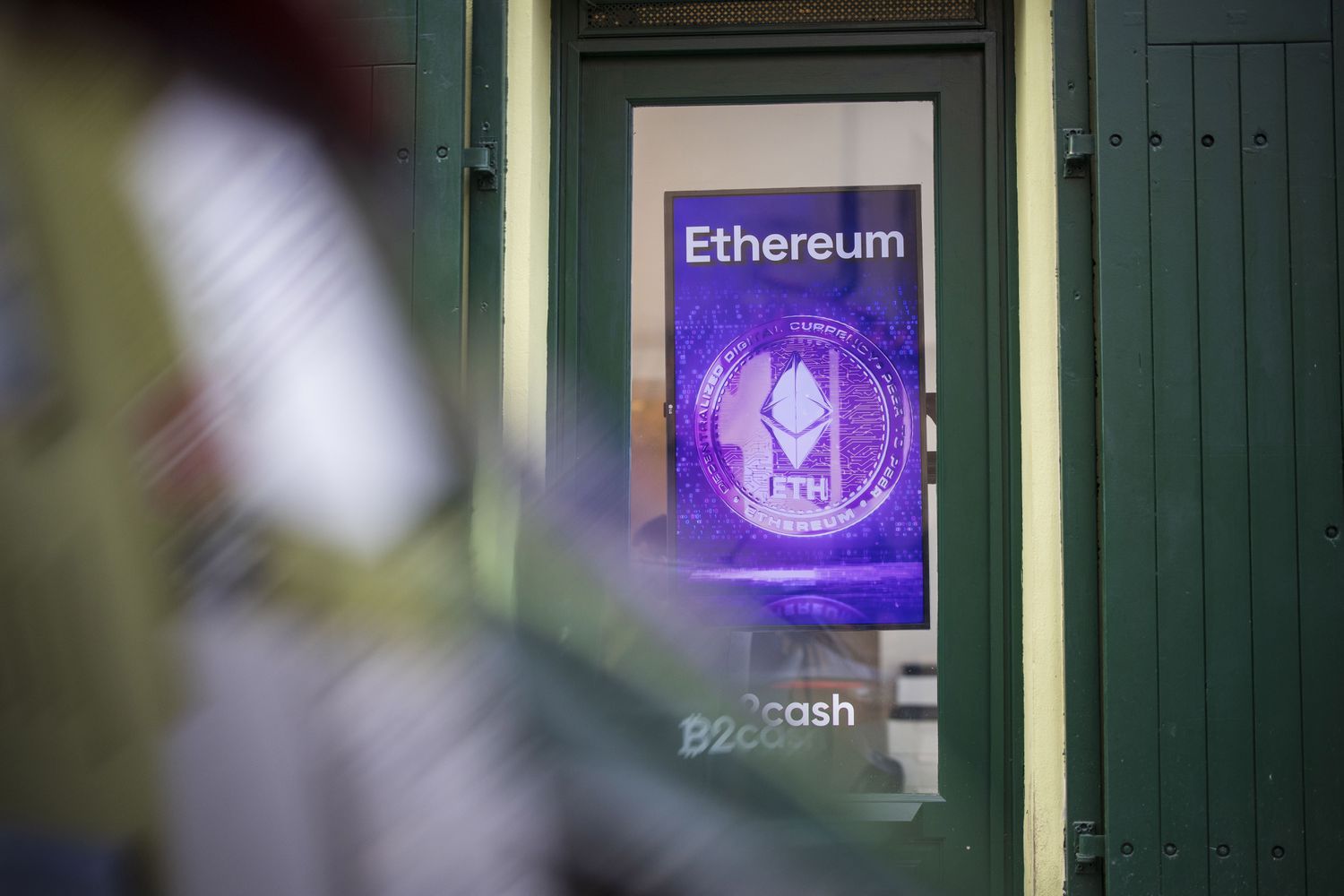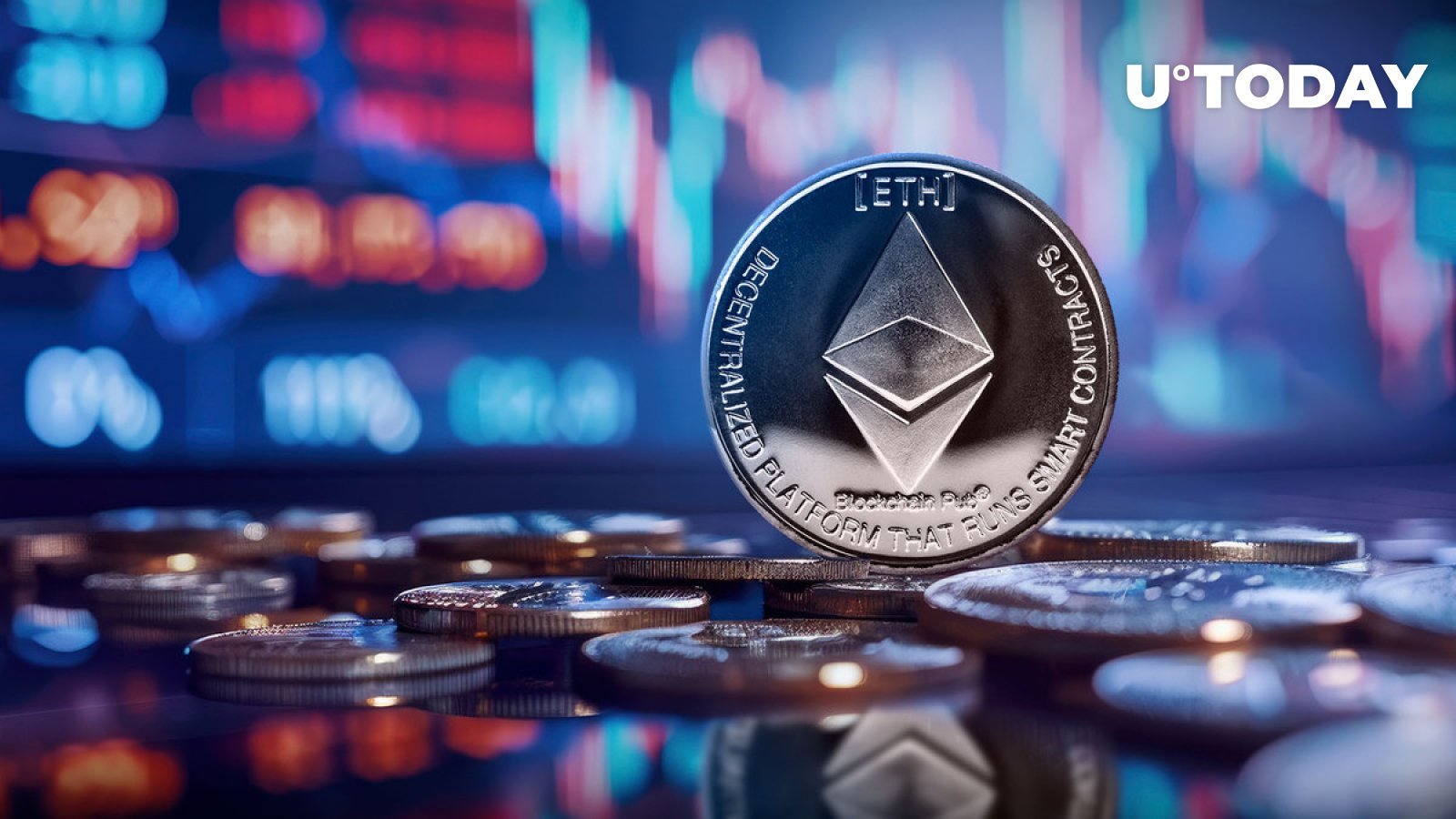Ethereum
What Is Ether (ETH), the Cryptocurrency of Ethereum Apps?

Ethereum and ether (ETH) are terms used for the ether digital currency, but that’s not quite right. Ethereum is the blockchain-based platform behind everything from financial transactions to digital art sales, all thanks to its coding language. By contrast, ether is the name of the cryptocurrency that fuels this digital ecosystem.
Understanding the distinction is a starting point for anyone looking to explore the world of digital assets. Below, we discuss the most important aspects of this cryptocurrency.
Key Takeaways
- Ethereum is a blockchain and distributed platform that allows anyone to create blockchain-based applications.
- As of May 2024, Ether (ETH) is the world’s second-largest cryptocurrency, with a market cap of about $380 billion.
- Ether pays for on-chain Ethereum transactions but can also be used as an investment, off-Ethereum payment method, or for trading on other crypto exchanges.
- Investors can also speculate on the price of ether through ether futures ETFs.
What Is Ethereum?
Ethereum is a decentralized development platform using blockchain technology. It was created to provide a base for building applications, cryptocurrencies, tokens, and other tasks needing distributed and secure databases.
With Ethereum, you can tokenize various types of information, from passwords and personal data to finances, real estate, and debt. Tokenization requires cryptographic techniques to secure and track ownership within the blockchain databases. The blockchain includes snapshots of the entire database, the cryptographic hash, and places them securely in each new block, making it impossible to alter past records.
Ethereum runs on a global network of computers (nodes) that work together to run programs called smart contracts and decentralized applications (dApps). This distributed network, powered by the Ethereum virtual machine (EVM), evades control of this information within a single system or entity, which is the decentralization blockchain proponents find crucial.
Developers use the EVM to build a wide range of dApps, including those with uses across society:
- Finance: dApps like Uniswap and Compound allow users to trade tokens or engage in decentralized finance (DeFi) directly from their digital wallets without the need for traditional banks. Imagine swapping tokens or securing a loan at any time, even in the middle of the night.
- Gaming: Ethereum hosts games like Axie Infinity, where players breed and battle digital creatures while earning rewards. It also powers virtual worlds like Decentraland, where users can buy virtual land, attend events, and socialize.
- Governance: Ethereum is also a base for decentralized autonomous organizations (DAOs) like MolochDAO. These organizations use smart contracts to make community decisions, which proponents say eliminates the need for traditional forms of governance.
While blockchain offers enhanced security, it’s important to remember that Ethereum isn’t resistant to every threat.
Ethereum is part of a movement toward a more decentralized internet that provides increased anonymity and security.
What Is Ether?
Ethereum, like any complex system, needs resources to function. It’s a distributed network, meaning there’s no central owner, but the computers (nodes) that keep it running need power and other resources to run. This requires some method of compensating for these costs. Think of it like paying your internet bill—someone has to pay for the service.
That’s where ether, Ethereum’s cryptocurrency, comes in. When you use Ethereum for an application or transaction, a small fee is paid in ETH. These fees cover the expenses of those running the nodes, like electricity and hardware. They also act as an incentive for people to contribute the use of their computer systems as a node in the wider EVP.
When discussing Ethereum’s price, you’re talking about the value of ETH. Ether is the payment method in the EVM and is used to pay network participants for the expenses (and a little extra) they incur for securing the blockchain and validating transactions.
Ether Uses
Ether has a market value that can be checked on any cryptocurrency exchange and most financial platforms. You’ll often see the name Ethereum, even though the data is for ether, the currency.
You can use ether to pay for goods or services at participating merchants and retailers. Investors, of course, trade ether for speculation, the quest to make money with money. They use strategies like those found in the stock market, such as buying and holding, day trading (buying and selling ETH throughout the day to capitalize on short-term price changes), scalping (making many small trades to profit from tiny price fluctuations), and arbitrage (taking advantage of price discrepancies between different ether exchanges).
(For more, see Investopedia’s Crypto Strategy and Education gateway.)
Like all cryptocurrencies, ether is volatile and has wide price swings. Therefore, any product derived from it is susceptible to the same swings.
How to Buy Ether
Although ether is the native cryptocurrency for Ethereum, it is also found on most cryptocurrency exchanges. You can find it on popular exchanges like Coinbase, Kraken, Gemini, Binance.US, and KuCoin.
To buy ether, you need a wallet compatible with your chosen exchange or use that exchange’s wallet. Generally, you link a bank account with your wallet and transfer funds to the exchange to begin trading.
Should You Invest in Ether?
Whether to buy crypto was once only a question for a few tech enthusiasts and early adopters, but now it’s commonly asked by many mainstream investors. How you answer depends on what you want to use it for. For instance, if you want to shop online with fewer entities knowing what you’re doing, ether is an excellent way to do that. You only need to buy the amount of ether you’ll need and spend it at an online retailer that accepts it. However, factor in the transaction fees Ethereum charges—you may pay a few dollars in fees for the convenience, plus sales tax.
If you’re considering investing in ether, it’s prudent to talk to a professional financial planner and discuss how ether might work as part of your portfolio. Cryptocurrencies are volatile, so it helps to have a professional’s assistance. To invest in ether, you could put money into companies developing products using Ethereum. For example, ConsenSys, a blockchain software company, builds tools and applications directly on the Ethereum platform. Others, like Microsoft Corporation (MSFT) and Amazon.com Inc. (AMZN), have been using Ethereum-based products for identification security and supply chain tracking for about a decade. Meanwhile, gaming firms, such as the developers of Decentraland and Axie Infinity, utilize Ethereum to create virtual worlds and digital experiences.
Ether Futures ETFs
Advantages and Disadvantages of Ether Futures ETFs
Pros
-
An easier way to invest in ether
-
No need to worry about safely storing the currency
-
ETFs are regulated investments
Cons
-
Ether can only be tracked with derivatives contracts
-
Returns may not mirror the returns from ether
-
Expense ratios can be high
-
ETF holdings are tied to the value of ETH, which is not a regulated investment
Trusts and funds from firms like Grayscale Ethereum Trust (ETHE), a publicly traded company that manages crypto-based exchange-traded funds (ETFs), are also available. These provide investors with exposure to ether without needing to purchase or store the cryptocurrency directly. ETHE is traded over the counter, meaning you can trade shares through your regular brokerage account. Its ETFs are also available that way.
Typically, ETFs track the price performance of their subject by investing in a portfolio of them. However, the U.S. Securities and Exchange Commission (SEC) has prohibited ETF managers from directly holding ether in their portfolios. However, the SEC has allowed ETFs to hold a portfolio of futures contracts tied to the expected prices of ETH. Futures are contracts to buy or sell an asset at a preset price on a given date. By holding these contracts, the ETF provides a means for mainstream investors to speculate on the value of ether through regulated exchanges in the U.S.
Ether futures ETFs like the VanEck Ethereum Strategy ETF (EFUT) and the ProShares Ether Strategy ETF (EETH) began trading in October 2023. Their debut was underwhelming. However, once spot bitcoin ETFs were approved a few months later, interest in crypto and the value of ETH spiked. In short order, EFUT and EETH nearly doubled their post-listing returns. Soon enough, though, their value pulled back significantly but still above their October 2024 pricing, demonstrating the volatility of crypto-related securities.
Two notable drawbacks of futures ETFs are higher fees than holding crypto directly (derivatives bringing more managerial complications), which can produce less returns than the target asset. To invest, find a broker that offers these types of ETFs, then open an investment account and start trading.
Ether Spot ETFs
Ether ETFs can only invest in futures contracts, not ETH tokens. Fund managers like VanEck, Grayscale, and Fidelity want to change that, having applied to the SEC to offer ETFs that directly hold ether.
Once spot bitcoin ETFs were approved, proponents thought the SEC might look more favorably on the idea than it had previously when it rejected earlier spot ETH ETF proposals. In recent years, the SEC has ramped up its enforcement of digital assets (doubling the size of its crypto investigations unit in 2022 and 2023). As we’ve reported, it thus seems the regulator is less, not more, inclined to allow spot ether ETFs. Unlike bitcoins, which are classified as commodities and hence regulated by the Commodities Futures Trading Commission, the SEC thinks ether might be more like a security than its crypto cousin, which could further hold up ETH ETF proposals. Meanwhile, the SEC hasn’t given up its well-known skepticism about crypto as investments.
If ETH is a security, all the SEC’s relevant regulations on trading them would apply, including transparency rules, not just when trading ether but also before a spot ETH ETF could trade on U.S. exchanges. The crux of the issue appears to be one major difference between Ethereum and Bitcoin, which is the former’s staking mechanism. Ethereum participants lock up their ether for collateral to support the platform’s blockchain in exchange for rewards. In the past, the SEC has initiated enforcement actions against exchanges like Kraken for their staking products, which it says are illegal, unregulated securities offerings. The SEC was already reluctant to allow spot bitcoin ETFs—an August 2023 appeals court ruling appeared to force its hand—and this seems to provide it with the reason it needs to keep spot ETH ETFs off American exchanges for now.
Is Ether a Good Investment?
Whether ether is a good investment depends on your outlook. If you believe ether’s price will go up, you can tolerate cryptocurrency’s risks and invest money you can afford to lose, ether might be a suitable investment. It’s always best to talk to a financial advisor before buying a cryptocurrency (or any investment product) to ensure you can withstand the volatility.
What Is Proof of Stake (PoS), and How Does It Relate to Ethereum?
PoS is a consensus mechanism used by blockchain networks to validate and secure transactions. In PoS, validators are chosen to create new blocks and confirm transactions based on the number of cryptocurrency tokens they hold and are willing to “stake” as collateral. It uses far less energy than its earlier proof of work model, which remains the means by which new bitcoins are produced.
How Much Will Ethereum Be Worth in 2030?
It’s difficult to predict a cryptocurrency’s price in 2030—or even if it will still exist.
Any outcome depends on Ethereum’s adoption rates, technological advances, regulatory developments, market sentiment, and macroeconomic factors.
The Bottom Line
Ether is a cryptocurrency used in Ethereum’s global virtual machine. It was created to compensate Ethereum participants for securing the blockchain and validating transactions, but it can also be used to pay for various goods and services. People also buy the world’s second-biggest cryptocurrency with the view of later selling it at a higher price. Options for capturing returns from a rise in its price include ether futures ETFs, which trade on U.S. exchanges. Thus far, spot ether ETFs do not. Like other digital currencies, ether’s value is volatile.
The comments, opinions, and analyses expressed on Investopedia are for informational purposes only. Read our warranty and liability disclaimer for more info. As of the date this article was written, the author owns BTC and XRP.
Ethereum
Ethereum (ETH) Whales Are Getting Incredibly Bullish: Details

Cover image via www.freepik.com
Disclaimer: The opinions expressed by our editors are their own and do not represent the views of U.Today. The financial and market information provided on U.Today is intended for informational purposes only. U.Today is not responsible for any financial loss incurred while trading cryptocurrencies. Do your own research by contacting financial experts before making any investment decisions. We believe all content to be accurate as of the date of publication, but some offers mentioned may no longer be available.
Ethereum (ETH) Whales are making major moves in the cryptocurrency market, suggesting strong bullish sentiment despite short-term price volatility. According to crypto analyst Ali Martinez, these big investors have accumulated over 126,000 ETH in the last 48 hours, or about $440 million.
In a tweet, Ali wrote: “Ethereum whales have accumulated over 126,000 ETH in the last 48 hours, worth around $440 million.”
According to CryptoQuant CEO Ki-Young-JuWhales may be preparing for the next move in the market. Ju wrote in a tweet that “whales may be preparing for the next rally in altcoins.” He noted that the volume of limit buy orders for altcoins, excluding Bitcoin and Ethereum, is increasing, indicating that strong buy walls are being put in place.
Ethereum’s recent developments, including the recent launch of Ethereum spot ETFs in the US, appear to have increased its appeal among large holders, known as crypto whales. Ethereum recently celebrated nine years since its inception, and as the ETH network continues to evolve, it is likely to attract more institutional interest.
Related
According to data from Farside Investors, fund flows into U.S.-listed Ethereum spot exchange-traded funds turned net positive daily for the first time since their inception on July 31, primarily due to a decrease in outflows from the Grayscale Ethereum Trust.
Ethereum Price Drops Due to Market Crash
Bitcoin and Ethereum, along with the majority of other crypto assets, appear to be underperforming during Thursday’s trading session.
According to CoinMarketCap dataAt the time of writing, Bitcoin’s price was $64,034, down 2.77% from the previous day. Ethereum’s price is down 4.21% from $3,175, where it was 24 hours ago. Several cryptocurrencies were posting larger losses; Solana’s Dogwifhat was down 12% in the past 24 hours, and PEPE was down 7% in the same period.
According to CoinGlass, price followers have led to the liquidation of $225 million worth of derivatives contracts over the past day.
Ethereum
Ethereum (ETH) Price Hits $50,000? Target Updated by Analyst

Vladislav Sopov
Extreme skepticism from Ethereum (ETH) detractors has prompted a veteran researcher to double down on Ether
Read U.TODAY on
Google News
Ethereum (ETH) proponent and AI enthusiast Adriano Feria has presented an extremely optimistic Ether price prediction. After the reaction of skeptics, he reconsidered the target, increasing it by 100%. His views are aligned with those of major institutional players, according to recent data.
Ethereum (ETH) bullish hypothesis should get us there: researcher
Ethereum (ETH) could hit $50,000 early in the current cryptocurrency market cycle. At the same time, a “bullish scenario” could push the price of the second-largest cryptocurrency to six-digit values, Web3 and AI educator Adriano Feria told X.
In a tweet shared with his 14,000 followers, Feria stressed that he is confident in the promising prospects of Ethereum (ETH) despite the massive wave of hatred against Crypto X. The doubters will regret their skepticism, the researcher admits:
If you hold ETH today, you are truly part of the global elite, because the bullish scenario for ETH should take us to $100,000. You think this is a joke, but there are real financial institutions around the world that have set bullish targets that are close to this. And no, this is not a joke.
Three days ago, he “increased” the $28,000 per ETH prediction published by Eric Conner, a veteran of the Ethereum (ETH) ecosystem and co-author of EIP 1559.
These ultra-bullish statements come amid growing disbelief triggered by ETH’s weak short-term performance.
The second-largest cryptocurrency failed to take off following the launch of the Ether ETF in the United States. At press time, Ethereum (ETH) was trading at $3,311, down nearly 6% from the local peak set after the ETF launched on July 23.
Insane BTC and ETH Price Predictions Released Every Day
As previously reported by U.Today, in February, Feria noted the rapid increase in popularity of ETH staking based on on-chain data.
In recent days, more and more analysts are sharing incredibly high predictions for Bitcoin (BTC) and Ethereum (ETH), the two largest cryptocurrencies.
For example, US asset management heavyweight VanEck has suggested two scenarios for the price of BTC in 2050.
The most optimistic scenario sees BTC surpassing $52 million per coin, while the $2.9 million mark is considered a “baseline” scenario by VanEck.
About the Author
Vladislav Sopov
Blockchain analyst and writer with a scientific background. 6+ years in computer analysis, 3+ years in blockchain.
I have worked in independent analysis as well as in start-ups (Swap.online, Monoreto, Attic Lab etc.)
Ethereum
Lloyd’s of London-backed insurance policies can now be paid in crypto on Ethereum

Lloyd’s of London, the three-century-old insurance marketplace, is supporting digital asset protection policies curated on the Ethereum public blockchain that can be paid for natively, on-chain, using cryptocurrency, through Lloyd’s Coverholder Evertas and smart contract insurance provider Nayms.
Not so long ago, any kind of cryptocurrency insurance coverage Finding solutions was difficult. Aside from the efficiency benefits of paying for insurance policies in cryptocurrency and using blockchain to streamline the burdensome paperwork of intermediaries, a consortium of Lloyd’s of London syndicates backing cryptocurrency-native, on-chain insurance shows how far the industry has come in the last two years.
“We’re enabling people using public blockchain infrastructure to interact with traditional, highly regulated, fiat-backed institutions in a transparent way,” Evertas CEO J. Gdanski said in an interview. “Whether it’s paying in USDC or native cryptocurrency, or placing policies entirely on-chain with blockchain helping coordinate between a broker, the policyholder, and insurers, we believe this is a foundational infrastructure.”
Nayms, a digital marketplace where brokers and underwriters connect with crypto capital investment, is a play on Lloyd’s “names,” the collection of individuals and companies that underwrite risks in the historic insurance market.
“The native cryptocurrency expertise we bring to the underwriting process gives us a deep understanding of the risks we insure,” Nick Selby, the company’s head of European underwriting, said in an interview. “It means we’re very explicit about what we do and don’t cover, and we can pay insured claims faster than anyone else.”
Ethereum
10 Years of Crypto Innovations! Here’s How Buterin Sees the Future of Ethereum!

2h45 ▪ 3 min read ▪ by Eddy S.
At the EDCON2024 conference, Vitalik Buterin unveiled the future directions of Ethereum, with a focus on innovative application development and wallet security. He presented promising projects and innovative ideas to improve privacy and accessibility for cryptocurrency users.
Ethereum’s new innovations by Vitalik Buterin!
Vitalik Buterin delivered a key speech on the future of Ethereum in the next ten years. He stressed that the priority of the crypto blockchain will now be to develop applications. Some of the already successful applications include decentralized finance (DeFi), decentralized identities (DID) with the Ethereum Name Service (ENS), DAOs and NFTs.
Vitalik also highlighted several promising projects. These include the prediction market Polymarket, the social media aggregator Firefly, the wallet Daimo, and the voting tool Rarimo. These applications illustrate the diversity and potential of Ethereum-based technologies to transform various sectors of crypto.
Vitalik also proposed several innovative ideas to improve the security and accessibility of Ethereum wallets. One of his proposals is to encrypt the private key directly into the cell phone’s chip! Thus turning the phone into a secure crypto wallet. Another idea is to place part of the private key in a regulatory-compliant custodial institution, thus providing an additional layer of security.
Vitalik also mentioned the use of zero-knowledge (ZK) proof technology to link KYC information to the wallet. This approach would ensure the privacy of cryptocurrency users while meeting regulatory requirements.
Security and Privacy: Two Requirements for Cryptocurrency Users
These proposals aim to improve the security and privacy of cryptocurrency users while facilitating the adoption of the technology by a wider audience. By combining technological innovations with practical applications, Ethereum continues to position itself as a leader in the cryptocurrency and blockchain ecosystem.
Vitalik Buterin’s speech highlighted Ethereum’s many advancements and future prospects. With a focus on application development and innovative proposals for crypto wallet security, Ethereum is well-positioned to continue to grow and innovate in the years to come.
Optimize your Cointribune experience with our “Read to Earn” program! Earn points for each article read and access exclusive rewards. Sign up now and start earning benefits.
Click here to join “Read to Earn” and turn your passion for crypto into rewards!
Eddy S.
The world is changing and adaptation is the best weapon to survive in this undulating universe. Originally a crypto community manager, I am interested in everything that is closely or remotely related to blockchain and its derivatives. To share my experience and promote a field that fascinates me, there is nothing better than writing informative and relaxed articles.
DISCLAIMER
The views, thoughts and opinions expressed in this article are solely those of the author and should not be considered investment advice. Do your own research before making any investment decision.
-

 Videos9 months ago
Videos9 months agoCrypto News: Bitcoin, ETH Price, CPI Print, PYTH, WIF & MORE!!
-

 Videos9 months ago
Videos9 months agoCrypto News: Bitcoin Price, ETF, ETH, WIF, HNT & MORE!!
-

 DeFi9 months ago
DeFi9 months agoMetasphere Labs announces follow-up event regarding
-

 Videos9 months ago
Videos9 months agoSolana price potential?! Check out THIS update if you own SOL!!
-

 Videos8 months ago
Videos8 months agoWho Really CONTROLS THE MARKETS!! Her plans REVEALED!!
-

 DeFi6 months ago
DeFi6 months agoPump.Fun Overtakes Ethereum in Daily Revenue: A New Leader in DeFi
-

 DeFi6 months ago
DeFi6 months agoDegens Can Now Create Memecoins From Tweets
-

 News6 months ago
News6 months agoNew bill pushes Department of Veterans Affairs to examine how blockchain can improve its work
-

 News6 months ago
News6 months agoLawmakers, regulators to study impact of blockchain and cryptocurrency in Alabama • Alabama Reflector
-

 Bitcoin6 months ago
Bitcoin6 months ago1 Top Cryptocurrency That Could Surge Over 4,300%, According to This Wall Street Firm
-

 Ethereum8 months ago
Ethereum8 months agoComment deux frères auraient dérobé 25 millions de dollars lors d’un braquage d’Ethereum de 12 secondes • The Register
-

 Videos8 months ago
Videos8 months agoCryptocurrency News: BTC Rally, ETH, SOL, FTM, USDT Recover & MORE!






